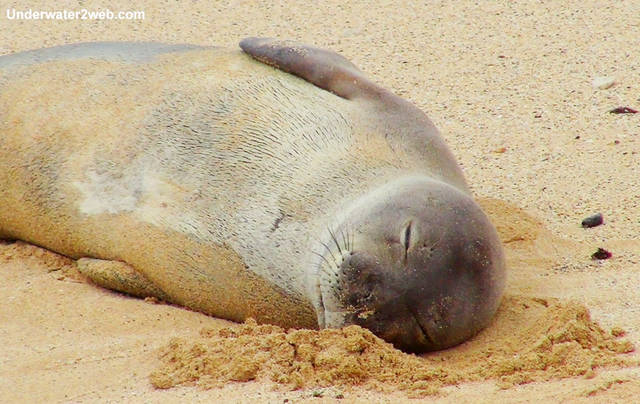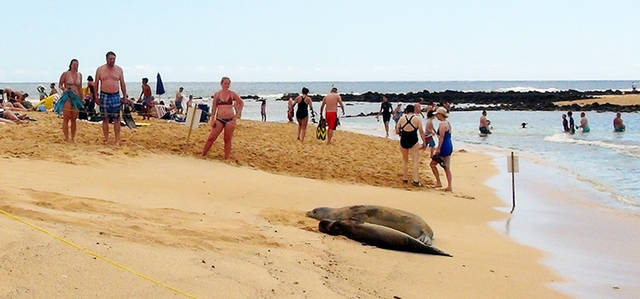POIPU — A sea of sunbathers usually descends upon Poipu Beach mid-morning and dotted among the bright suits and umbrellas, creatures of the deep soak up the same warmth.
Though both residents and visitors tend to crowd around the sleeping Hawaiian monk seals as they haul out for their daily rest, the animals snore on peacefully most days.
But over the past three months, there have been more of them.
Currently, an average of between three and five seals are reported daily at Poipu as compared to between one and five seals reported over the past few years, according to the National Oceanic and Atmospheric Association.
The uptick has caused concern for some residents, who are worried about the potential conflicts between the seals and humans, but NOAA officials say it’s not unusual.
“We have observed this pattern many times in the past and most likely the numbers of seals will fluctuate month to month,” said Jamie Thompton, NOAA’s Kauai marine mammal response coordinator.
He continued: “The Poipu area has been a popular place for monk seals since they started returning to Kauai in the 1990s.”
It’s not the only place in Hawaii that’s seeing an uptick in seals, either. According to NOAA’s Wednesday released 2017 annual population update, the Hawaiian monk seal population has had a 2 percent annual growth rate since 2013, when the range-wide estimates began.
The population was estimated at 1,400 seals in 2017, with about 1,100 seals in the Northwestern Hawaiian Islands and 300 seals in the main Hawaiian Islands. As far as babies, 161 pups were counted in the Northwestern Hawaiian Islands in 2017 and 34 were counted in the main Hawaiian Islands.
Poipu Beach is also popular with the island’s human population, and co-existence between the two species is a challenge, especially with the number of seals on the rise.
A model for that delicate balance has been struck on the south shore, however, and it all relies on two things: seal resting areas and humans using common sense.
“Through the years, we have learned that monk seals at Poipu rest undisturbed if people remain about 20 feet away,” Thompton said.
He continued: “It’s important to remember that monk seals are large carnivores and should not be approached, however, they are also curious animals and not generally aggressive.”
Roped-off seal resting areas can be seen nearly every day at the beach, and at other locations around Hawaii in increasing numbers.
Potential dangers
Terry Lilley, who has been filming underwater footage on Kauai, says he’s concerned that more seals coming to the island means more people could get hurt, even though the animals aren’t usually aggressive.
“These monk seals are very large top wild predators, not puppy dogs,” Lilley said. “I dive with these monk seals and have had them be very aggressive, even biting divers’ fins, dive gear and cameras.”
He pointed out many tourists feed the fish in the waters fronting Poipu Beach, and says he thinks that’s a recipe for disaster when it comes to the carnivorous creatures.
“Feeding fish in the middle of 500-pound top predators with tourists in every square inch is just not a good idea,” he said. “I think the monk seals may be hanging out at Poipu Beach Park as they can eat and sleep right in the same spot.”
Hawaiian monk seals eat a variety of fish species at depths ranging from the reef to more than 1,500 feet. Reef fishes, lobsters, eels, small octopus and squid make up their diet, according to NOAA.
While seals are hunters who can become aggressive, Thompton said they aren’t generally outright so and are — for the most part — just curious carnivores with a taste for seafood.
“The one exception to this are mothers with pups,” Thompton said. “As with many other species, monk seal mothers are extremely protective of their young and have bitten people.”
When it comes to seals in the water, Thompton said there is ample evidence to suggest ongoing co-existence.
“We are frequently observing seals swimming in the vicinity of snorkelers and surfers around Kauai, including Poipu, without incident,” Thompton said. “It primarily appears to be a shared use situation where people are swimming in an area that seals use.”
Patterns in sunbathing
Monk seals typically haul-out in the morning and many times will remain all day until around sunset, sleeping. Nights are spent foraging; however, the pattern varies between seals and locations, according to NOAA.
Seasonal patterns for monk seal behavior and haul-out locations include things like pup season, which is typically in the spring or summer, but can happen any time of year.
“Mothers typically choose quiet, remote locations,” Thompton said.
Male monk seals have hormone spikes in the summer, which is the peak of the breading season and results in the males “cruising” in search of adult females.
“We often see males cruising the shoreline looking for seals hauled out on the beach, investigating things that may look like seals such as logs, turtles, (and) sunbathing humans,” Thompton said.
Human efforts, like the seal sleeping zones and listing the animals as endangered, have aided in boosting population numbers.
The creation of the monk seal hospital, Ke Kai Ola on Hawaii Island, has also helped. The hospital’s existence hasn’t increased the number of seals on Kauai, but has helped the existing population by rehabilitating sick and injured seals.
The seals are returned to the sites where they are captured after treatment, and one seal has been treated from Kauai, RH38.
That is just one of many seals that cruise around Kauai, and officials remind people to treat the seals like the wild animals they are when the two species cross paths.
In their 2017 population update, NOAA states that though the population of Hawaiian monk seals seems to be thriving, it isn’t what it used to be.
“While recent population growth offers encouraging signs that strong conservation efforts can lead to progress, the monk seal population remains just over one-third of historic (1950’s) levels,” the report says. “This highlights the importance of continued dedication to aid the recovery of this unique Hawaiian species.”
With conservation of that species comes the need for coexistance, scientists say, and that’s a conversation that’s happening internationally with many different species and situations.
“Human co-existence with wildlife is a great challenge around the world, especially in the case of critically endangered species such as the Hawaiian monk seal,” Thompton said. “It’s our responsibility to ensure they don’t go extinct, but also our responsibility to ensure that co-existence with human use is considered.”



